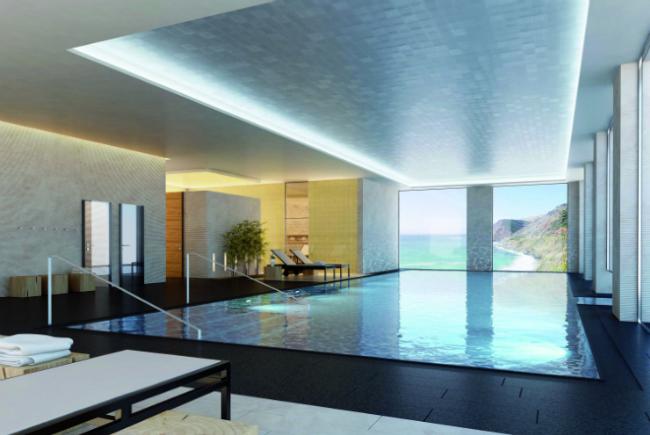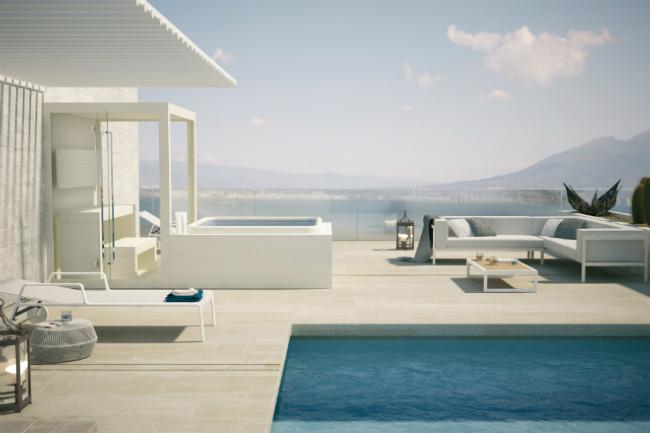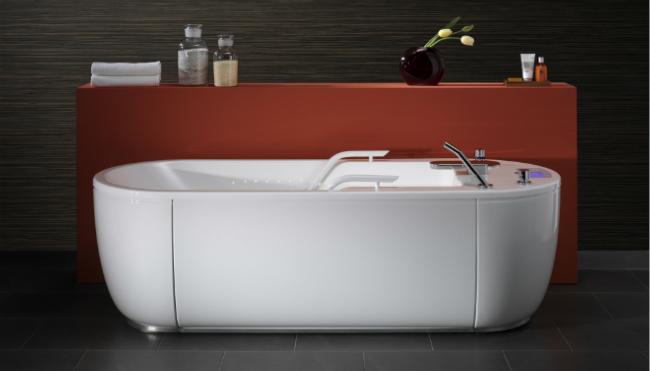Taking the plunge
Regardless of the size of your spa and the features you have, the water facilities you install will be among the biggest investments you make.
Not only are features such as pools and experience showers costly to purchase, they are also expensive to operate efficiently and keep clean, hygienic and safe. Which naturally also makes it important to choose the right facilities for your business, location and clientele.
“The first thing we always tell our customers is that water experiences are expensive: they’re expensive when you invest in them and, especially if you’re considering pools, they’re also very expensive to operate,” says Mario Stiefler, senior consultant at spa design and consultancy company Thermarium.

Above: Image credit Thermarium
Experts agree that there is no such thing as an industry-wide right or wrong when it comes to the water features that are the best match for your spa; rather it depends on the particular business. “The first step is always to find out who your customers are: to define your target group, think about your location and consider who comes to your spa,” says Adrian Egger, managing director of the spa division at spa and wellness facilities provider Klafs.
Knowing your clientele is essential because, as Egger emphasises, installing water facilities you have seen at other properties, without regard for their suitability for your market, is not a recipe for success. “There is too much copying in the industry, many people think that because something worked in one location, it should also work in their spa,” he comments.
“And that’s just not true because if it’s not part of your concept, it’s unlikely to be successful. If you don’t have the right target group, who are willing to pay the right price, then the facilities will just be losing money by the day.”

Above: Image credit Carmenta Wellness
Cost & calculations
Cheryl Hanna, spa sales manager at Barr+Wray, which supplies pools and provides water engineering solutionsfor spas, explains that another key consideration to take into account is the weather.
“The location and surroundings will determine which facilities you should offer,” she says. “For example, as a result of the warm climate, there is generally a greater demand for large outdoor pools in regions like the Middle East and Asia, while the weather in a country like the UK makes outdoor pools difficult to run successfully.”
And while all spas must by definition have some type of water facilities, bigger isn’t automatically better. “If you are a city business hotel, for example, then it doesn’t necessarily make sense to have a huge number of water facilities,” Stiefler comments. In fact, one area where spas often go wrong is trying to provide more water features than they really need.
“Think about the space you have,” Egger says. “Don’t put too much in; if it has no added value, there’s no point.” Chris Perry, UK sales director for Carmenta Wellness, whose range of spa and wellness equipment includes pools, steam rooms and experience showers, advises against prioritising quantity over quality. “You’re better off having fewer, more high-end, facilities with a bit of theatre and wow factor than cramming a lot of poor-quality stuff that customers have seen a million times over into your spa,” he says.
Gerard McCarthy, sales director at Dalesauna, whose spa and wellness equipment includes hydrobaths, ice rooms and hydrotherapy pools, agrees that investing in quality pays off. “If you’re not willing to spend the money to get it right, then don’t do it, because there is n comprise really,” he says.
“You either do it right, or you don’t do it at all.” Egger adds that, while spas may be under the impression that they’re saving money by opting for less expensive features, this can backfire. “If, for example, you have six showerheads and all of them are dripping because you invested in a cheaper product, you’ll be losing money from day one,” he says.

Above: Image credit Klafs
Creating an experience
While a greater number of pools, baths and experience showers isn’t always better, making sure that the water features you do have offer the right balance to keep guests occupied and entertained while they’re in the spa is crucial.
“A selection of wet experiences is essential for a holistic spa journey that creates a memorable experience and encourages return visits,” says Heinz Schletterer, founder and chief executive of spa development, design and management company Schletterer.
Perry explains that “you need to give clients water features that will make them want to spend the day in the spa and relax – and that mean they can do that without getting bored. It’s about retaining customers on your premises for longer; the more time they spend there, the more likely they are to part with their money.”
Supporting this view, Hanna says that “customers are attracted by the variety of what is offered in terms of water facilities and they’re more inclined to visit a spa with [water facilities] of varying temperatures and aesthetics; providing different experiences.”
Hanna also suggests that spas consider investing in water features you can directly derive revenue from. “We would recommend moving towards water facilities that provide an experience or treatment and that you can therefore charge for; such as Kneipp pools, Watsu pools, hydrotherapy pools and thalassotherapy pools,” she says.

Above: Image credit Barr + Wray
Return on investment
Even if you don’t use your water features to generate revenue directly, by offering treatments and experiences for which customers need to pay, a more impressive wet area can contribute to the profitability of your business in less direct ways.
“Even if you are not able to, or choose not to, charge customers to use your hydrotherapy pool or hydrobath, for example, you will be able to charge more for your day or half-day packages, because you are including the use of these facilities,” McCarthy says.
This is a point of view with which Schletterer agrees, commenting that “it’s more the entire package that guests are willing to pay extra for, rather than one particular feature.”
Water features that can be used for treatments have the advantage of allowing spas to offer a service for which they can not only charge, but which requires minimal therapist involvement. “Once the therapist has showed you to the room and switched the bath on, she can then go away for half an hour or so, while you get this wonderful water massage – which makes it a very cost-effective investment,” McCarthy comments.

Above: Image credit Schletterer
Reducing operating costs
It is an accepted industry fact that operating costs for water-based features, particularly pools, are high. With this in mind, you might assume that all spas draw up a detailed business plan and carefully consider the pros and cons before making their investments.
According to the experts that would, however, be an incorrect assumption. “I think that a lot of people either don’t really think about the costs of water-related features, or underestimate it,” McCarthy says. Thermarium provides consultancy services to spas around the world, and Stiefler says that as many as “90% of customers just invest in these facilities, without really having much of an idea of what they will cost them in the long run, or what kind of return on investment the business will get from them.”
While water operating costs are destined to remain on the higher end of the spectrum, there are ways to bring them down. “Energy optimisation is essential and using the latest technologies and water systems can help reduce water consumption and energy costs dramatically,” Schletterer says

Above: Image credit Dalesauna
Egger urges spas to “think about smart, energy-saving concepts that use the right materials,” adding that: “At Klafs we, for example, offer something called Green Steam; a special isolated steam outlet that helps reduce energy costs by up to 35%.”
Keeping the water in pools clean is essential, but McCarthy explains that spas often opt for the more costly and less efficient way of doing this. “The most common mistake is probably trying to keep the water sanitised by adding chemicals, when the best and cheapest option is always to just empty part of the water out and fill the pool up with fresh, clean water,” he says.
Despite the unanimous agreement that each spa must consider its own unique set of circumstances when deciding which water facilities are right for them, there are nevertheless general rules that apply across the board. “Keep it energy efficient, make sure clients are impressed, add theatre without going beyond your means when it comes to space or budget. And, of course, make sure you know your clients and tailor the facilities to what they want,” Perry summarises.
www.barrandwray.com
www.carmentasrl.com
www.dalesauna.co.uk
www.klafs.com
www.schletterer.com
www.thermarium.com

